Improved PWM Methods to Reduce the Common Mode Voltage of the Five-Phase Open-Winding Drive Topology
Abstract
:1. Introduction
- (1)
- High DC voltage utilization rating. Due to the supplement of dual inverters, the DC voltage utilization rating of the motor system can be improved, effectively widen the motor speed range with the same DC voltage level. Additionally, with the same motor speed range requirement, the desired DC voltage level can be reduced.
- (2)
- Multilevel modulation effect. Three-level modulation effect can be achieved in the open-winding topologies supplied by two inverters. Compared with the traditional three-level topologies, structures of open-winding topologies are simpler and the undesirable capacitor voltage balancing problem is avoided.
- (3)
- High control flexibility. Due to the open-winding structure, each winding current can be independently controlled. Hence, the current and terminal voltage of the fault winding will not affect the healthy winding which helps to simplify the design of fault-tolerant control scheme, and thus improves the reliability of the drive system.
2. Improved CPWM Methods with CMV Suppression Effects
2.1. CMV under Traditional CPWM
2.2. CMV under Carrier-Reversed PWM
2.3. CMV under Carrier-Switching PWM
3. Dead-Time Effects on CMV Suppression
- (1)
- if (define the bridge leg current when it flows out of the bridge leg, otherwise ), when the upper switch turns on, flows through the upper switch and the bridge leg equals . When the upper switch turns off, flows through the lower diodes and equals . That is, waveform of the bridge leg voltage is consistent with the upper switch’s function .
- (2)
- if , when the lower switch turns on, will flow through the lower switch and the bridge leg equals . When the lower switch turns off, flows through the upper diodes and equals . That is, waveform of the bridge leg voltage is the inversion of its lower switch’s function .
3.1. Dead-Time Effects in Carrier-Reversed PWM
3.2. Dead-Time Effects of Carrier-Switching PWM
- (1)
- dead-time effects in the switching period without carrier changing
- (2)
- dead-time effects in the switching period with carrier changing
4. Experiment Verification
4.1. CMV Comparison under Different PWM Methods
4.2. Comparison of the Current Quality under Different PWM Methods
4.3. Common-Mode EMI (CM EMI) Characteristic Comparison under Different PWM Methods
5. Conclusions
- (1)
- Compared with the traditional CPWM, by employing reversed carriers for the INV2, the CMV can be eliminated under the CRPWM. Due to dynamically switching of the inverted carriers under the CSPWM, sub CMV in two inverters can be effectively suppressed, leading to an 80% and 50% decline of the CMV amplitude and step times.
- (2)
- Under the CRPWM, odd-order high frequency harmonics increase, and winding currents clearly deteriorate. Under the CSPWM, current distortion is slight due to the employment of sawtooth carriers. The CSPWM is a compromise method between the CMV suppression effect and the current quality.
- (3)
- The dead-time delay does not affect the CMV suppression effects of the CRPWM method. Under the CSPWM, ripples and low voltage level caused by the dead-time delay exist in pairs in sub CMVs, and the suppression effects of CMV amplitude and step times remain unchanged.
Author Contributions
Funding
Institutional Review Board Statement
Informed Consent Statement
Data Availability Statement
Conflicts of Interest
Abbreviations
| CPWM | carrier-based pulse width modulation |
| CRPWM | carrier-reversed PWM |
| CSPWM | carrier-switching PWM |
| SVPWM | space vector pulse width modulation |
| CMV | common-mode voltage |
| EDM | electric discharge machining |
| EMI | electromagnetic interference |
| INV | inverter |
| FFT | fast Fourier transform |
| THD | total harmonic distortion |
References
- Levi, E. Multiphase electric machines for variable-speed applications. IEEE Trans. Ind. Electron. 2008, 55, 1893–1909. [Google Scholar] [CrossRef]
- Peng, X.; Liu, Z.; Jiang, D. A review of multiphase energy conversion in wind power generation. Renew. Sustain. Energy Rev. 2021, 147, 111172. [Google Scholar] [CrossRef]
- Liu, Z.; Fang, L.; Jiang, D.; Qu, R. A Machine-Learning-Based Fault Diagnosis Method with Adaptive Secondary Sampling for Multiphase Drive Systems. IEEE Trans. Power Electron. 2022, 37, 8767–8772. [Google Scholar] [CrossRef]
- Sadeghi, S.; Parsa, L. Design and dynamic simulation of five phase interior permanent magnet machine for series hybrid electric vehicles. In Proceedings of the 2010 IEEE Green Technologies Conference, Grapevine, TX, USA, 15–16 April 2010; pp. 1–6. [Google Scholar]
- Xu, J.; Zhang, B.; Fang, H.; Guo, H. Guaranteeing the fault transient performance of aerospace multiphase permanent magnet motor system: An adaptive robust speed control approach. CES Trans. Elect. Mach. Syst. 2020, 4, 114–122. [Google Scholar] [CrossRef]
- Song, Z.; Hu, S.; Zhang, R. Performance improvement of open winding PMSMs with a discrete-time designed zero-sequence current controller based on virtual three-phase expansion. IEEE Trans. Ind. Electron. 2020, 67, 10046–10054. [Google Scholar] [CrossRef]
- Somasekhar, V.T.; Gopakumar, K.; Baiju, M.R.; Umanand, L. A multilevel inverter system for an induction motor with open-end windings. IEEE Trans. Ind. Electron. 2005, 52, 824–836. [Google Scholar] [CrossRef]
- Kim, J.; Jung, J.; Nam, K. Dual-inverter control strategy for high-speed operation of EV induction motors. IEEE Trans. Ind. Electron. 2004, 51, 312–320. [Google Scholar] [CrossRef]
- Mu-Shin, K.; Seung-Ki, S. Control of an open-winding machine in a grid-connected distributed generation system. IEEE Trans. Ind. Appl. 2008, 44, 1259–1267. [Google Scholar]
- Zhu, L.; Zhang, F.; Jin, S.; Ademi, S.; Su, X.; Cao, W. Optimized Power Error Comparison Strategy for Direct Power Control of the Open-Winding Brushless Doubly Fed Wind Power Generator. IEEE Trans. Sustain. Energy 2019, 10, 2005–2014. [Google Scholar] [CrossRef]
- Sun, B.; Chen, Z.; Gao, C.; Haddad, A.; Liang, J.; Liu, X. A Power Decoupling Control for Wind Power Converter Based on Series-Connected MMC and Open-Winding PMSG. IEEE Trans. Ind. Electron. 2022, 69, 8091–8101. [Google Scholar] [CrossRef]
- Wu, F.; Zheng, P.; Sui, Y.; Yu, B.; Wang, P. Design and Experimental Verification of a Short-Circuit Proof Six-Phase Permanent-Magnet Machine for Safety Critical Applications. IEEE Trans. Magn. 2014, 50, 8204304. [Google Scholar] [CrossRef]
- Liu, H.B.; Yang, H. Design of Six-Phase Fault-Tolerant Permanent Magnet Synchronous Motor Used in Electric Vehicle. Small Spec. Electr. Mach. 2019, 47, 47–51. [Google Scholar]
- Kalaiselvi, J.; Srinivas, S. Bearing Currents and Shaft Voltage Reduction in Dual-Inverter-Fed Open-End Winding Induction Motor With Reduced CMV PWM Methods. IEEE Trans. Ind. Electron. 2015, 62, 144–152. [Google Scholar] [CrossRef]
- Kalaiselvi, J.; Srinivas, S. Hybrid PWMs for shaft voltage reduction in a dual inverter fed induction motor drive. In Proceedings of the Proceedings of the IEEE International Conference on Industrial Technology, Cape Town, Western Cape, South Africa, 25–28 February 2013; pp. 539–544. [Google Scholar]
- Erdman, J.M.; Kerkman, R.J.; Schlegel, D.W.; Skibinski, G.L. Effect of PWM inverters on AC motor bearing currents and shaft voltages. IEEE Trans. Ind. Appl. 1996, 32, 250–259. [Google Scholar] [CrossRef]
- Akagi, H.; Shimizu, T. Attenuation of conducted EMI emissions from an inverter-driven motor. IEEE Trans. Power Electron. 2008, 23, 282–290. [Google Scholar] [CrossRef]
- Reddy, B.V.; Somasekhar, V.T. An SVPWM scheme for the suppression of zero-sequence current in a four-level open-end winding induction motor drive with nested rectifier–inverter. IEEE Tran. Ind. Electron. 2016, 63, 2803–2812. [Google Scholar] [CrossRef]
- Somasekhar, V.T.; Gopakumar, K.; Shivakumar, E.G. A space-vector modulation scheme for a dual two-level inverter fed open-end winding induction motor drive for the elimination of zero-sequence currents. EPEJ 2002, 12, 1–19. [Google Scholar] [CrossRef]
- Karampuri, R.; Jain, S.; Somasekhar, V.T. Phase displaced SVPWM technique for five-phase open-end winding induction motor drive. In Proceedings of the 2016 IEEE Students’ Conference on Electrical, Electronics and Computer Science (SCEECS), Bhopal, India, 5–6 March 2016; pp. 1–6. [Google Scholar]
- Kumar, G.N.; Srinivas, S. Carrier based PWM methods for CMV elimination in open-end winding induction motor drive. In Proceedings of the 2018 IEEE 12th International Conference on Compatibility, Power Electronics and Power Engineering (CPE-POWERENG), Piscataway, NJ, USA, 10–12 April 2018. [Google Scholar]
- Liu, Z.; Zheng, Z.; Sudhoff, S.D.; Gu, C.; Li, Y. Reduction of common-mode voltage in multiphase two-level inverters using SPWM with phase-shifted carriers. IEEE Trans. Power Electron. 2016, 31, 6631–6645. [Google Scholar] [CrossRef]
- Xiong, W.; Sun, Y.; Su, M.; Zhang, J.; Liu, Y.; Yang, J. Carrier-based modulation strategies with reduced common-mode voltage for five-phase voltage source inverters. IEEE Trans. Power Electron. 2018, 33, 2381–2394. [Google Scholar] [CrossRef]
- Liu, Z.; Wang, P.; Sun, W.; Shen, Z.; Jiang, D. Sawtooth carrier-based PWM methods with common-mode voltage reduction for symmetrical multiphase two-level inverters with odd phase number. IEEE Trans. Power Electron. 2021, 36, 1171–1183. [Google Scholar] [CrossRef]
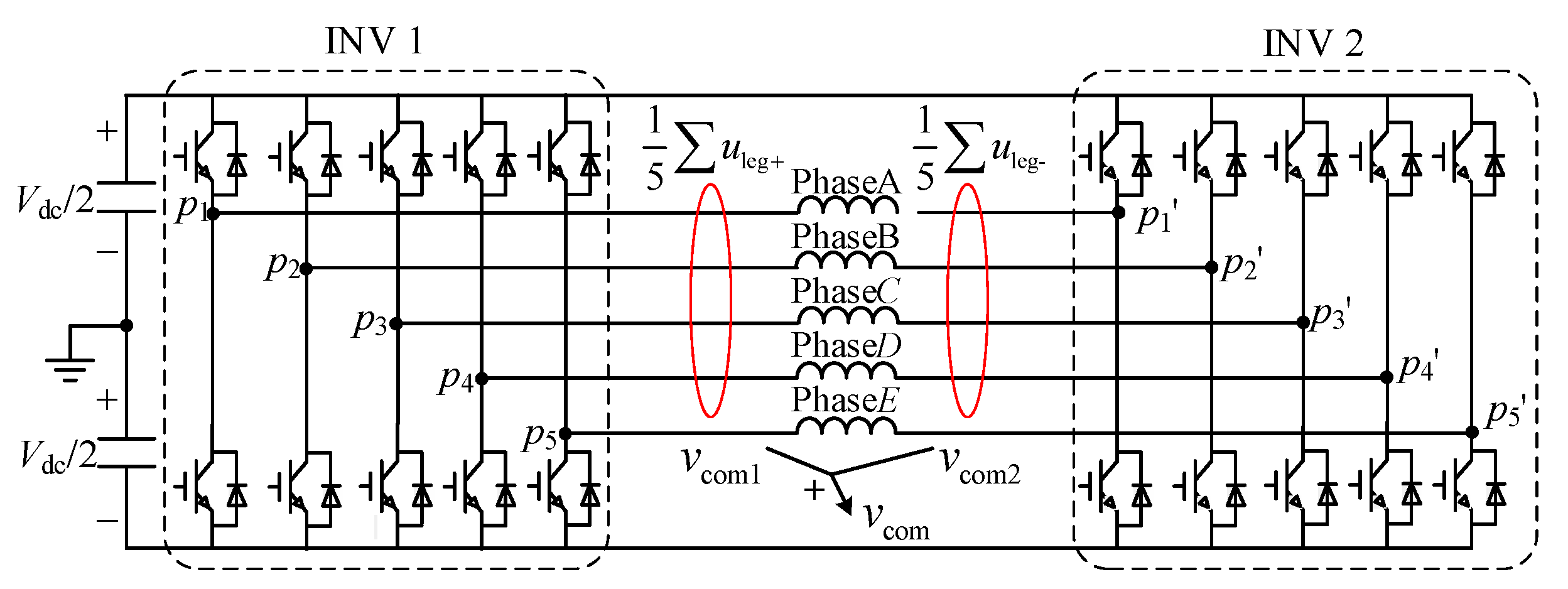

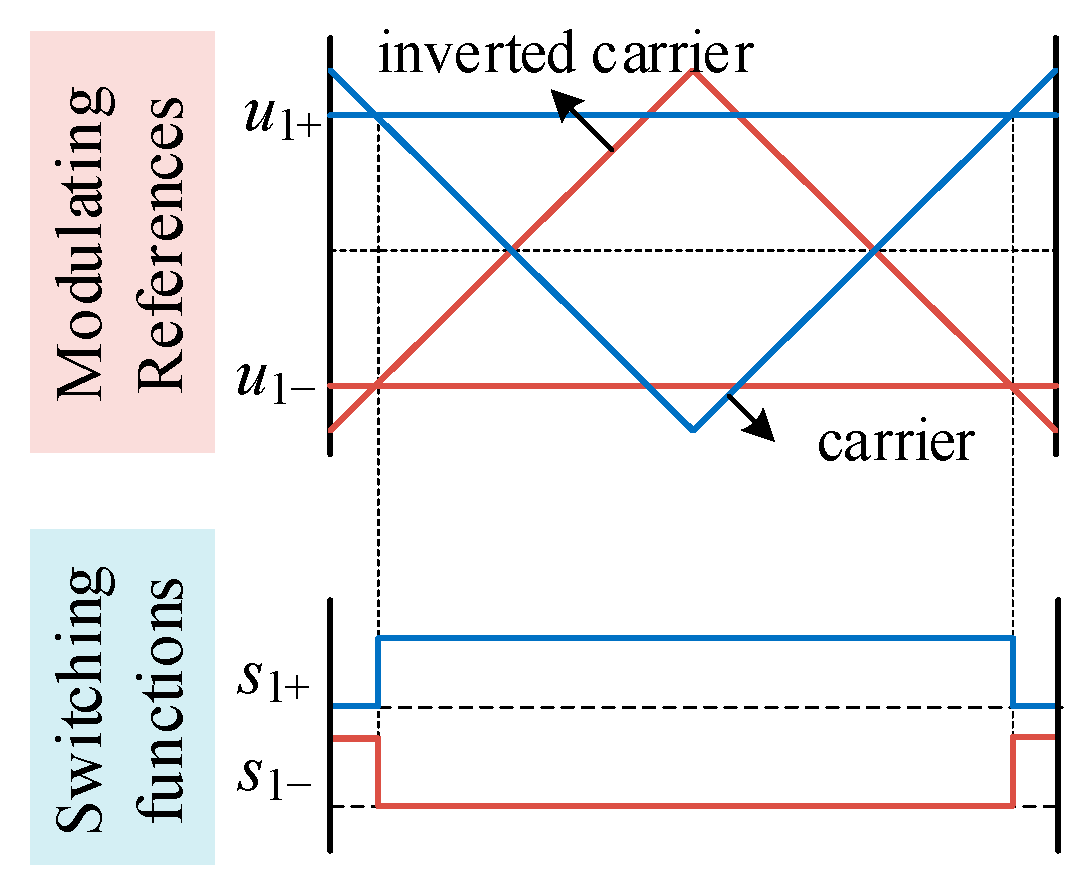
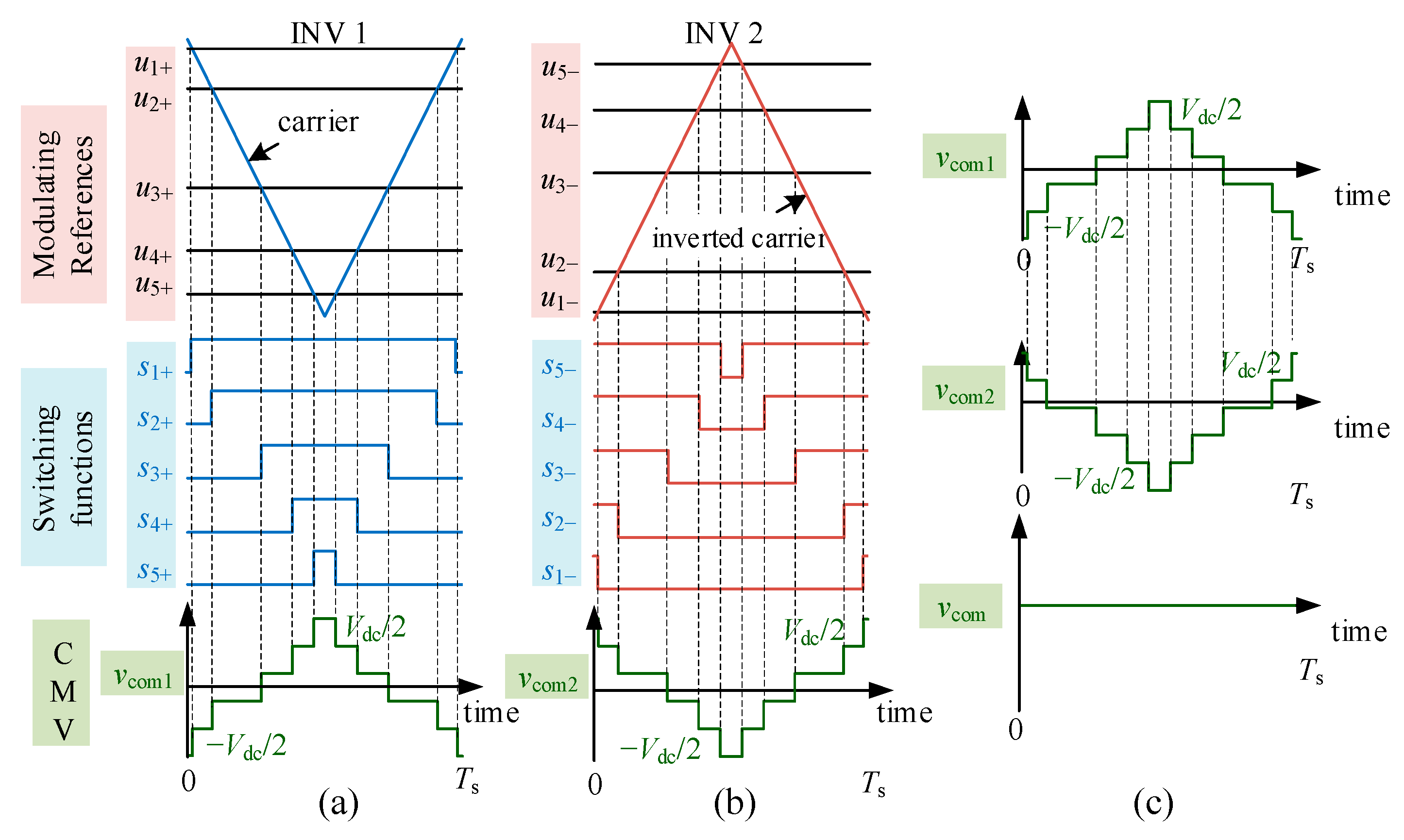
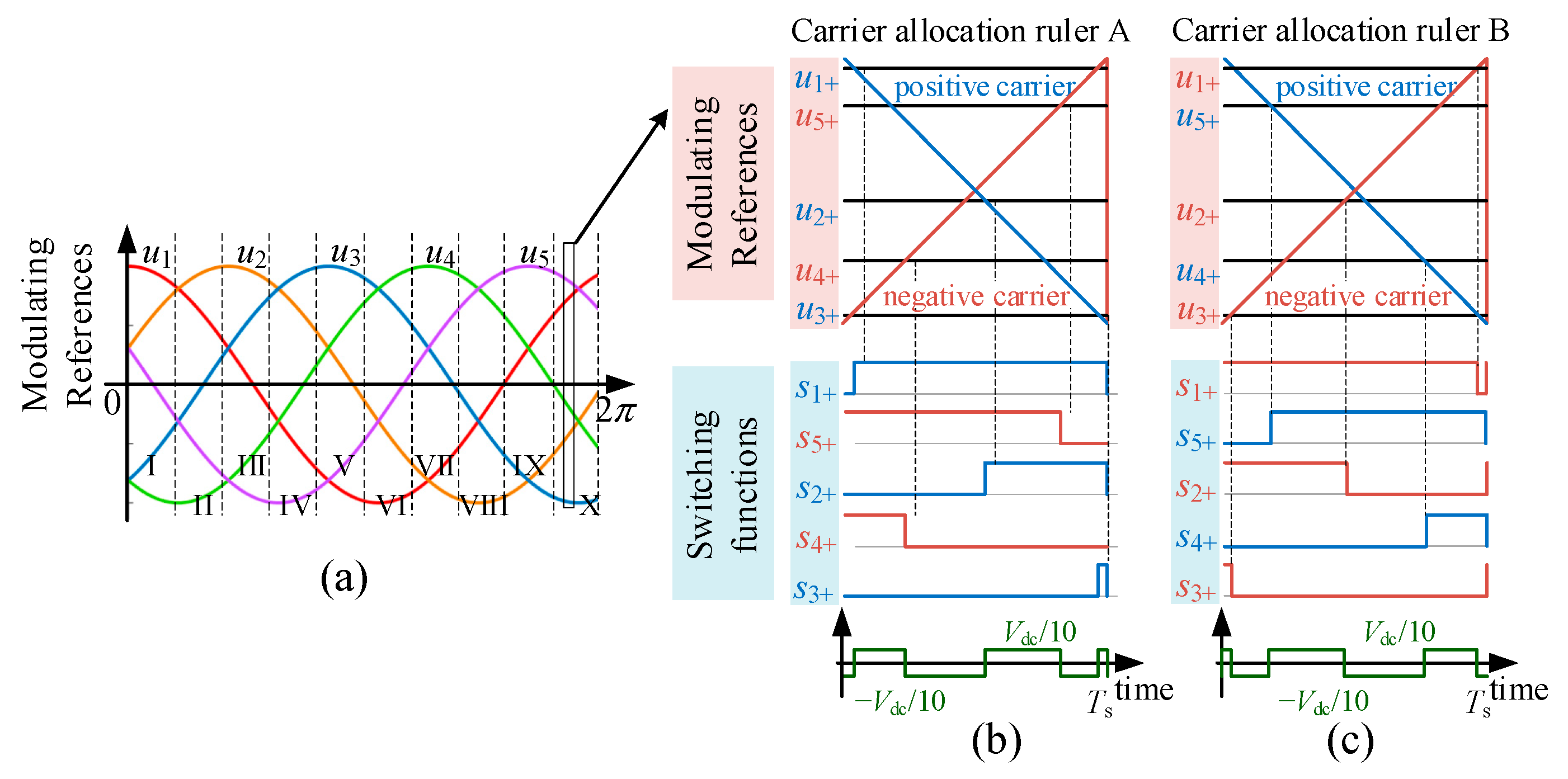

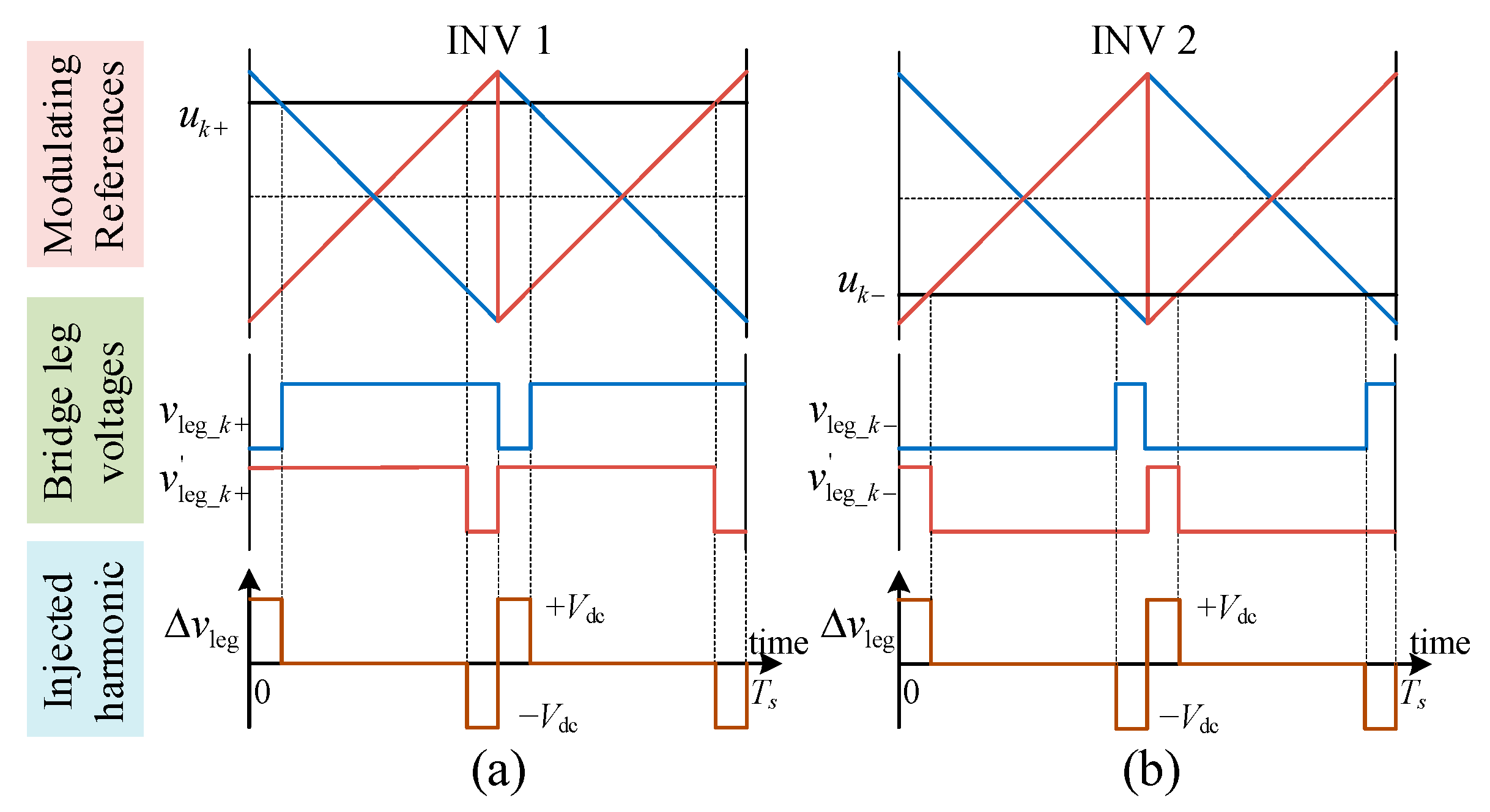

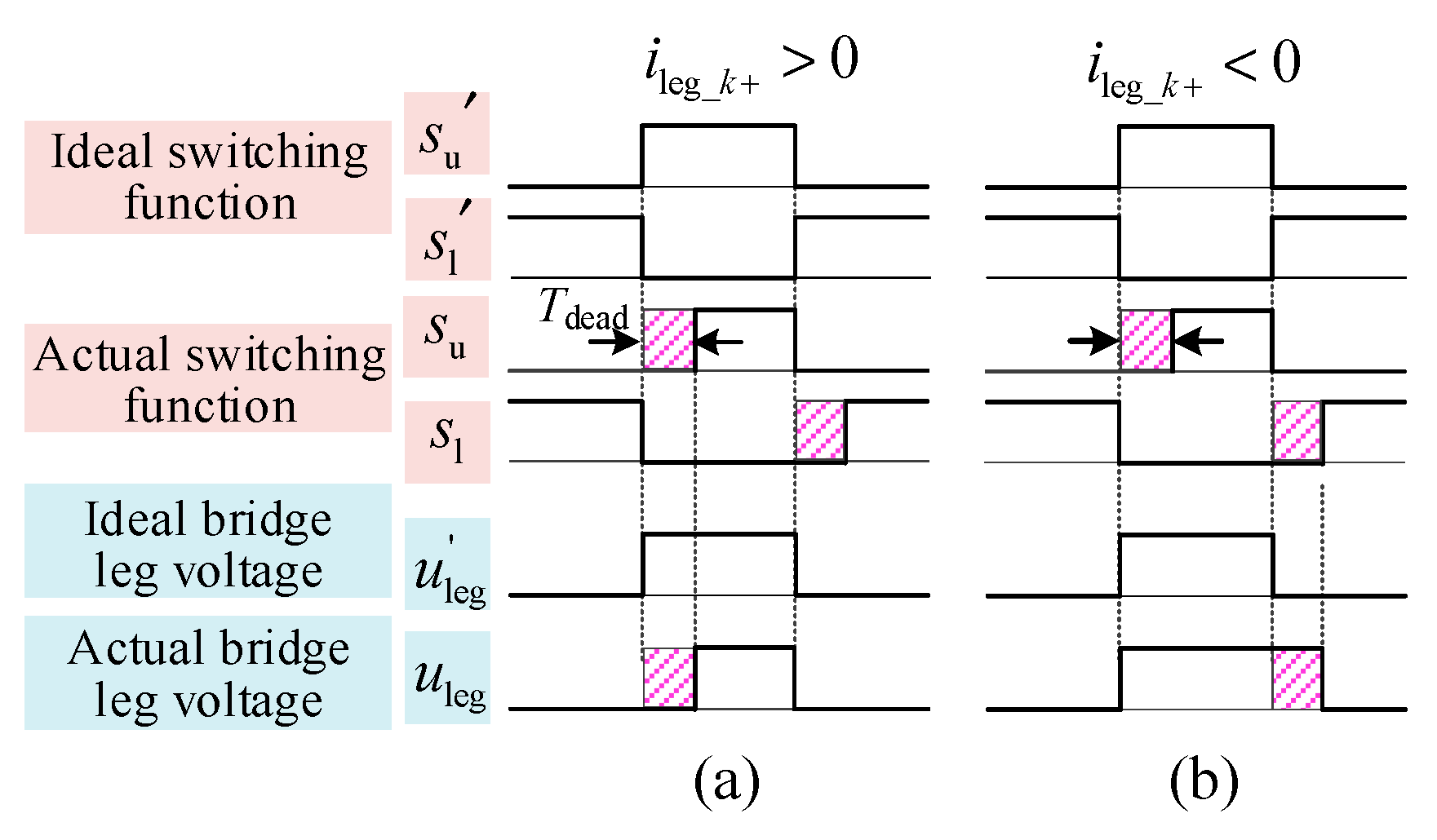
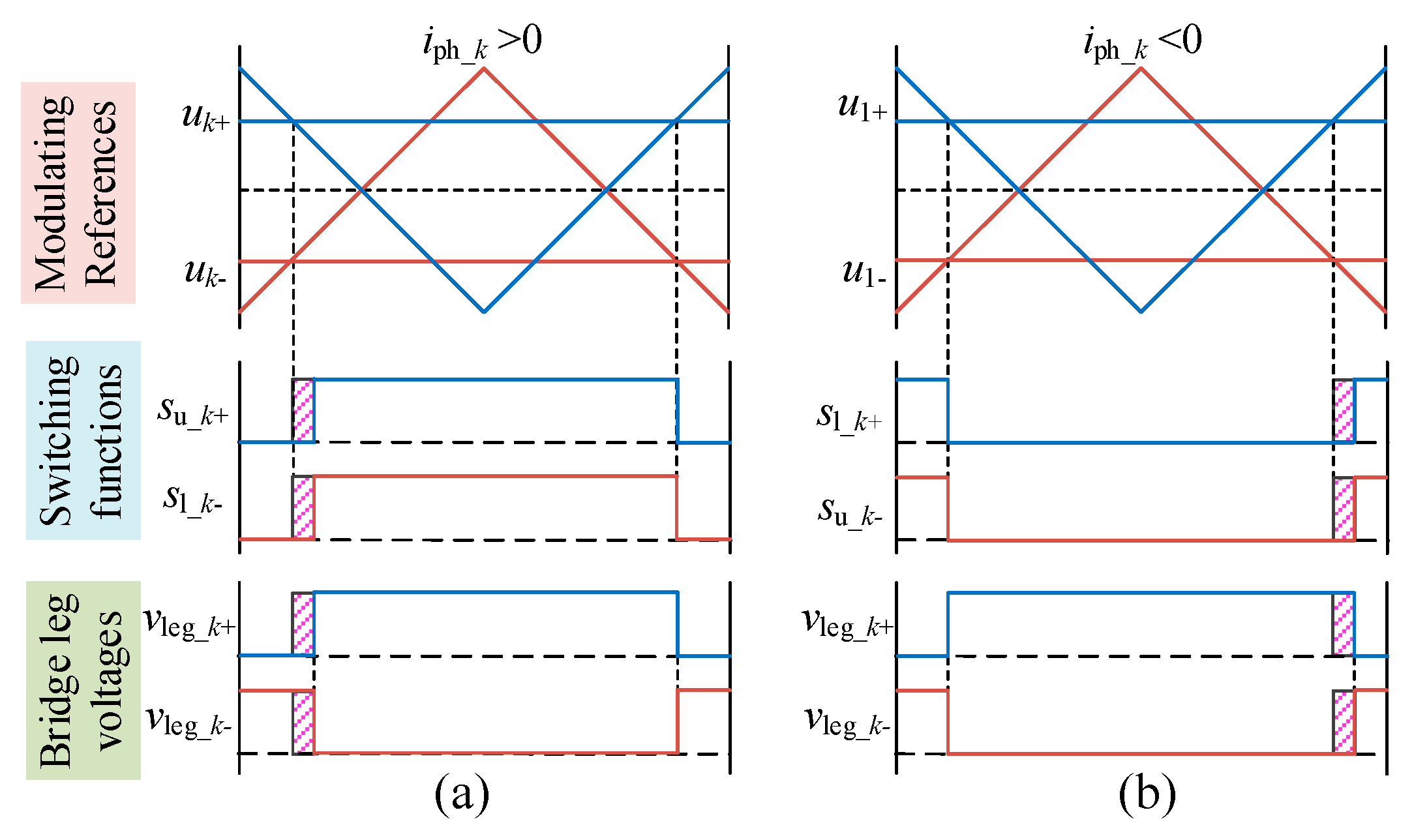
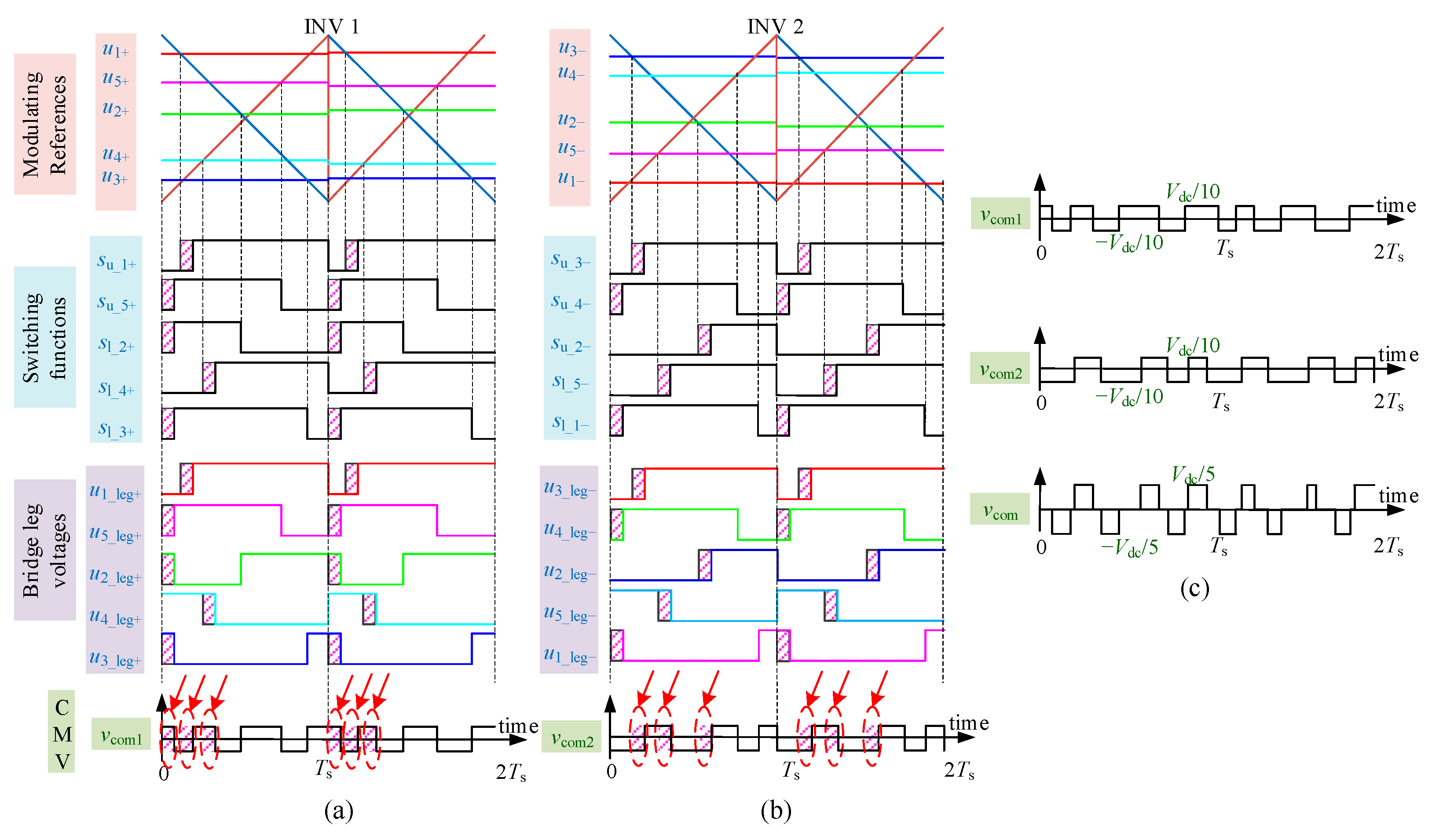
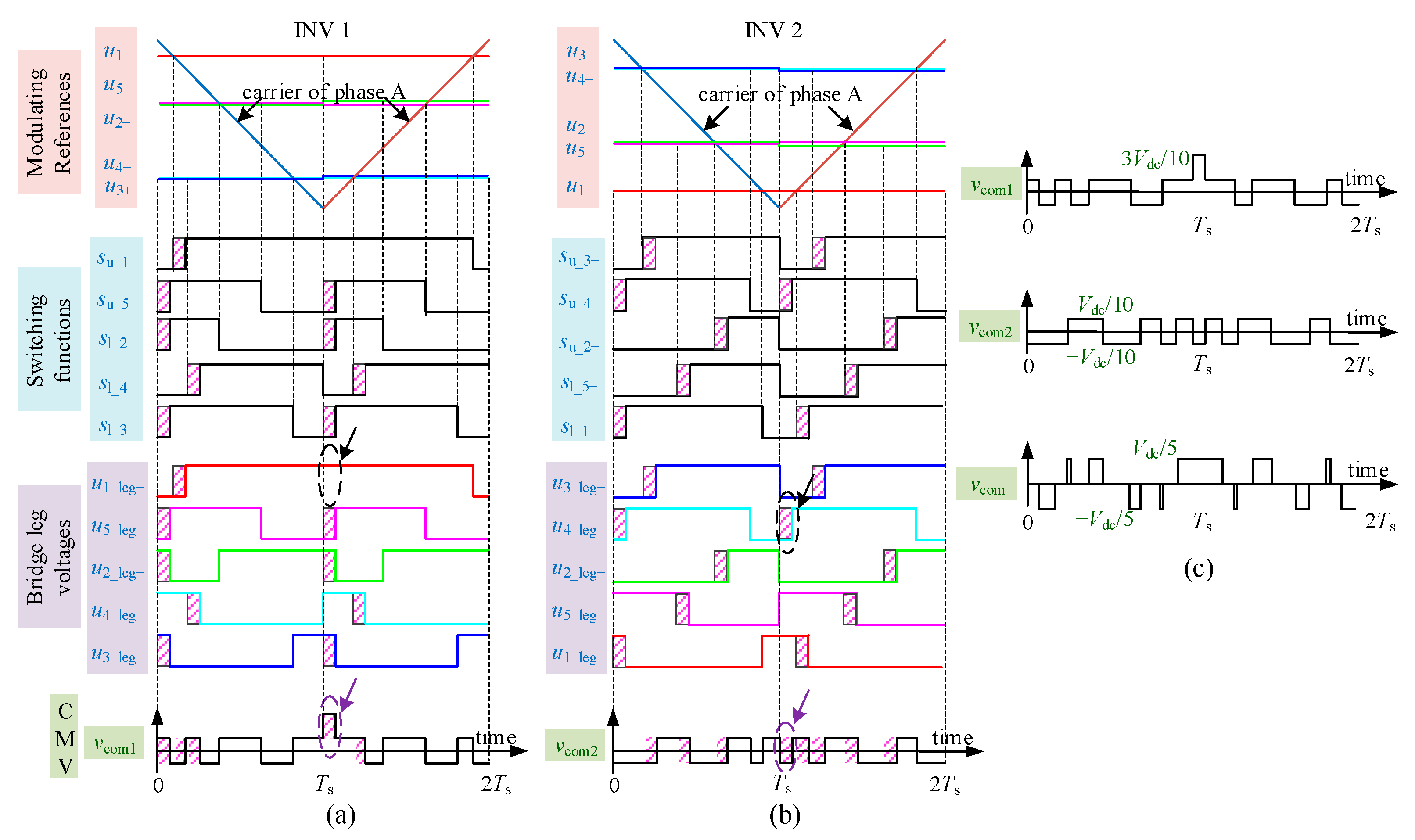
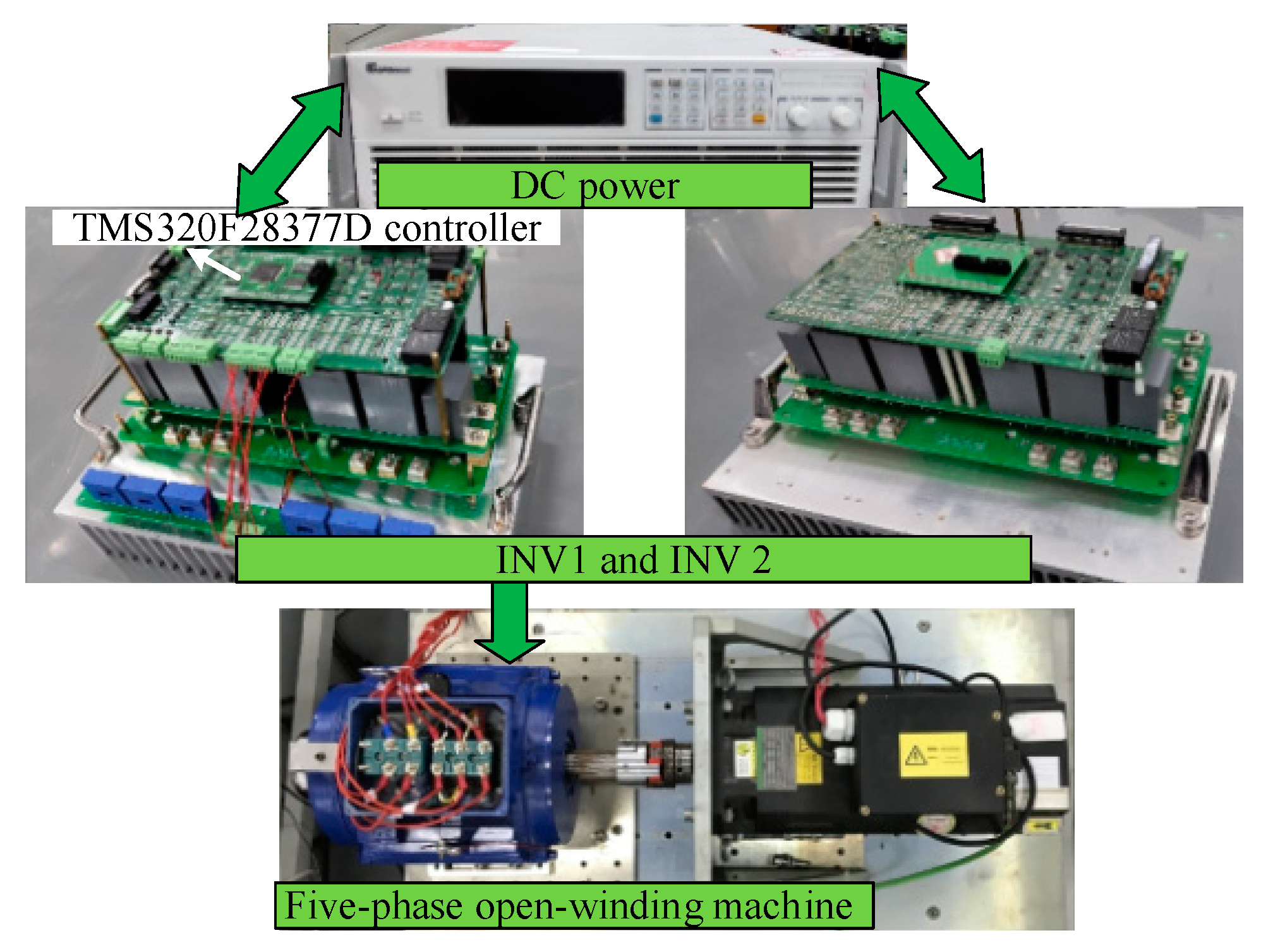

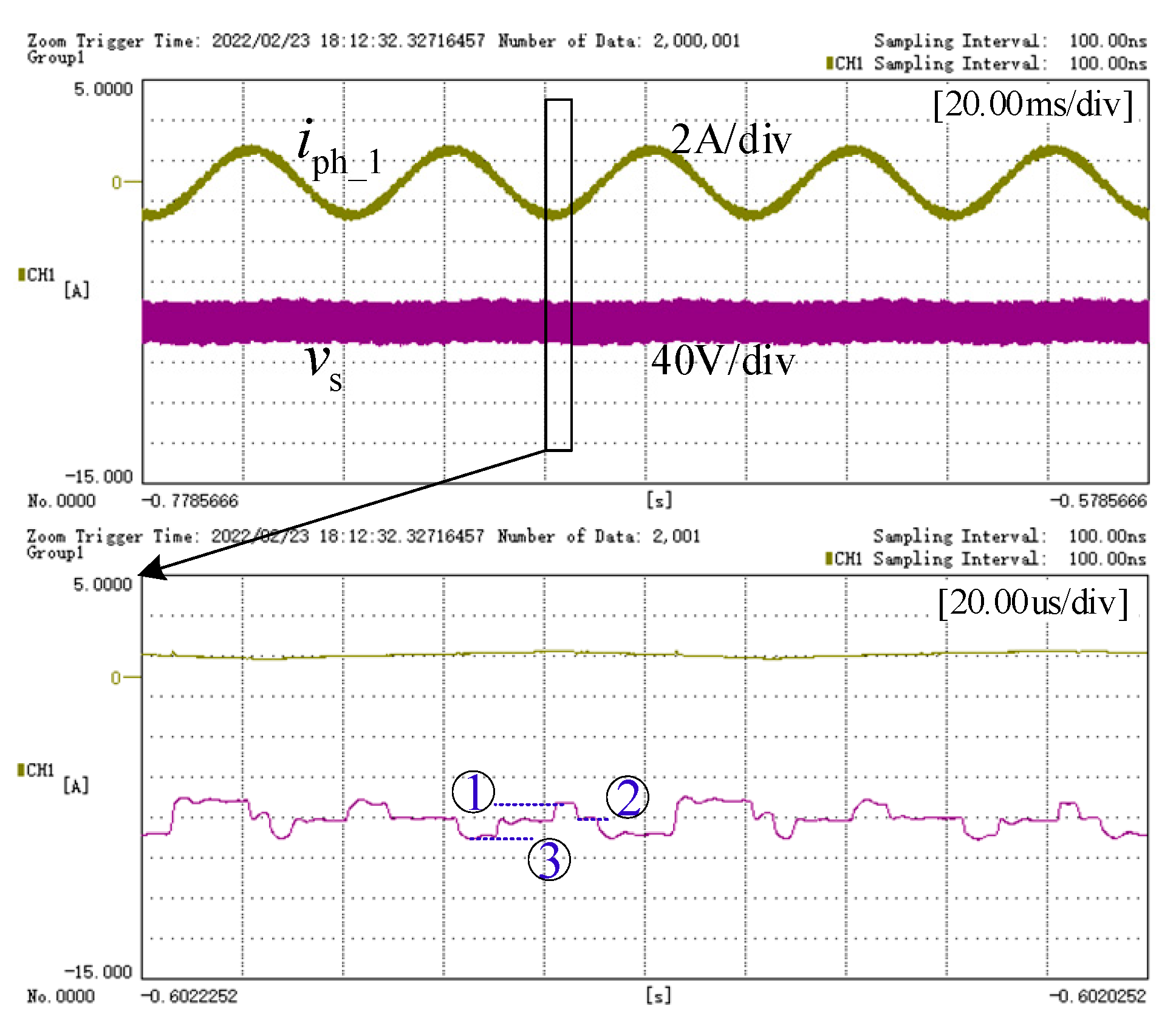

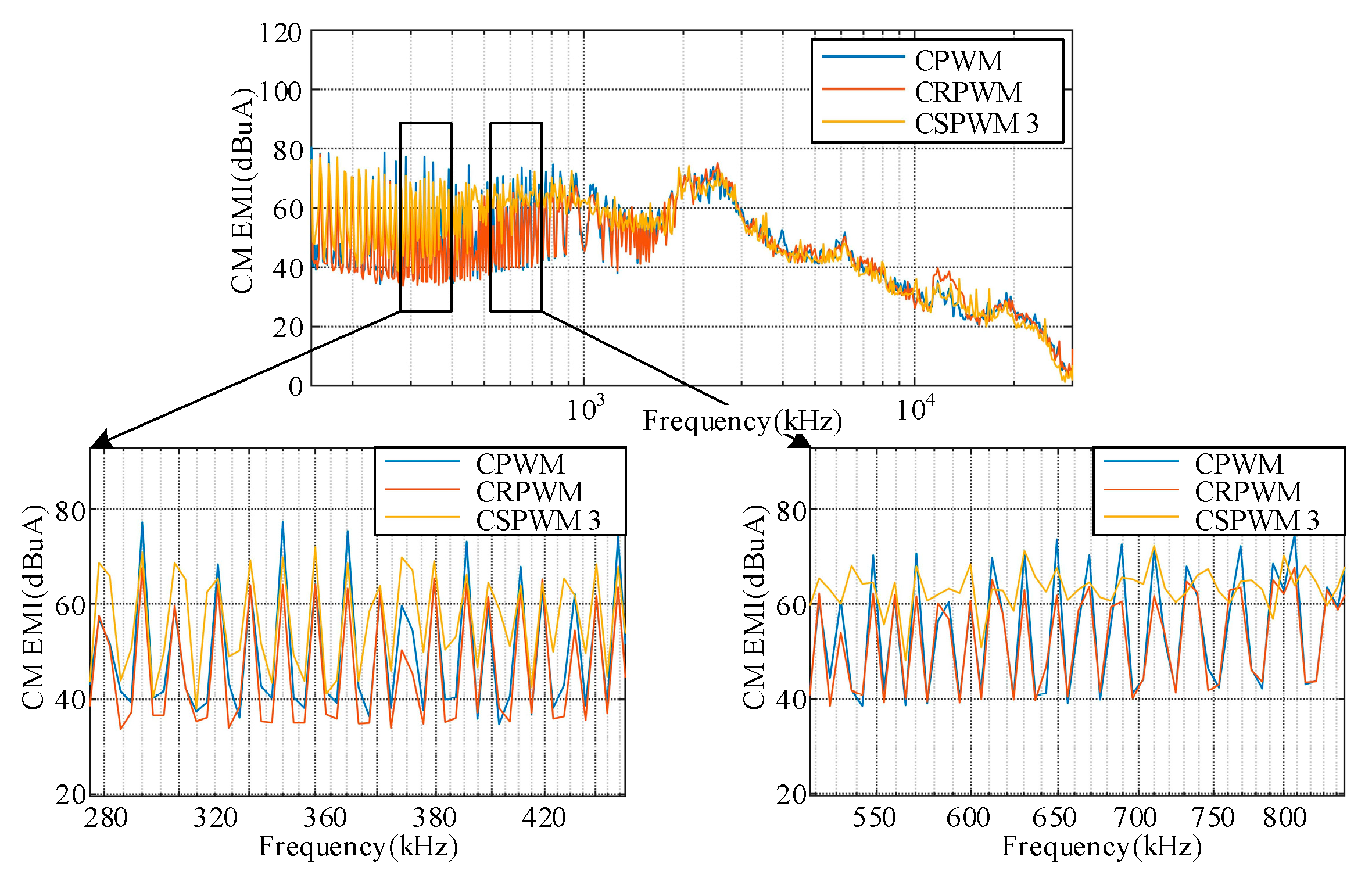
| CSPWM Schemes | Carrier Allocation Ruler in INV 1 | Carrier Allocation Ruler in INV 2 |
|---|---|---|
| 1 | ruler A | ruler A |
| 2 | ruler B | ruler B |
| 3 | ruler A | ruler B |
| 4 | ruler B | ruler A |
| Machine Parameters | Converter Parameters | ||||
|---|---|---|---|---|---|
| 4 kW | 203.3 mH | 10 kHz | |||
| 1.554 | 14.8 mH | 1 uS | |||
| 1.582 | 7.6 mH | 200 V | |||
| 1 | |||||
| Frequency Band/kHz | CM PWM Peak/ | ||
|---|---|---|---|
| Traditional CPWM | CRPWM | CSPWM 3 | |
| 150–200 | 80.36 | 78.05 | 77.06 |
| 200–300 | 78.68 | 70.95 | 73.41 |
| 300–500 | 77.28 | 65.39 | 72.04 |
| 500–1000 | 74.66 | 67.67 | 72.53 |
| 1 × 103–2 × 103 | 71.56 | 72.09 | 73.61 |
| 2 × 103–4 × 103 | 75.06 | 75.18 | 74.19 |
| 4 × 103–10 × 103 | 52.57 | 50.29 | 49.11 |
| 10 × 103–20 × 103 | 35.32 | 39.70 | 36.09 |
| 20 × 103–30 × 103 | 25.59 | 26.13 | 22.53 |
Publisher’s Note: MDPI stays neutral with regard to jurisdictional claims in published maps and institutional affiliations. |
© 2022 by the authors. Licensee MDPI, Basel, Switzerland. This article is an open access article distributed under the terms and conditions of the Creative Commons Attribution (CC BY) license (https://creativecommons.org/licenses/by/4.0/).
Share and Cite
Wang, P.; Liu, Z.; Jiang, D.; Tian, J.; Li, P. Improved PWM Methods to Reduce the Common Mode Voltage of the Five-Phase Open-Winding Drive Topology. Energies 2022, 15, 6382. https://doi.org/10.3390/en15176382
Wang P, Liu Z, Jiang D, Tian J, Li P. Improved PWM Methods to Reduce the Common Mode Voltage of the Five-Phase Open-Winding Drive Topology. Energies. 2022; 15(17):6382. https://doi.org/10.3390/en15176382
Chicago/Turabian StyleWang, Pengye, Zicheng Liu, Dong Jiang, Jie Tian, and Peng Li. 2022. "Improved PWM Methods to Reduce the Common Mode Voltage of the Five-Phase Open-Winding Drive Topology" Energies 15, no. 17: 6382. https://doi.org/10.3390/en15176382
APA StyleWang, P., Liu, Z., Jiang, D., Tian, J., & Li, P. (2022). Improved PWM Methods to Reduce the Common Mode Voltage of the Five-Phase Open-Winding Drive Topology. Energies, 15(17), 6382. https://doi.org/10.3390/en15176382









